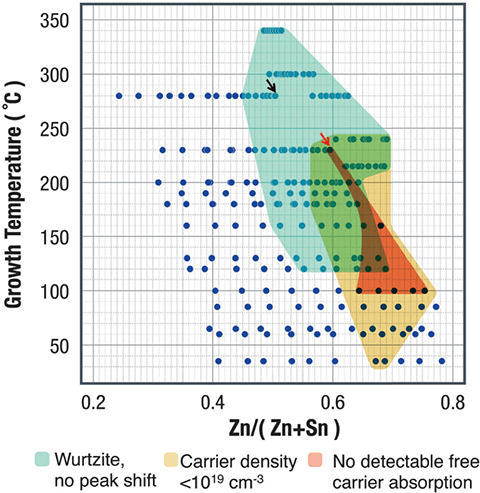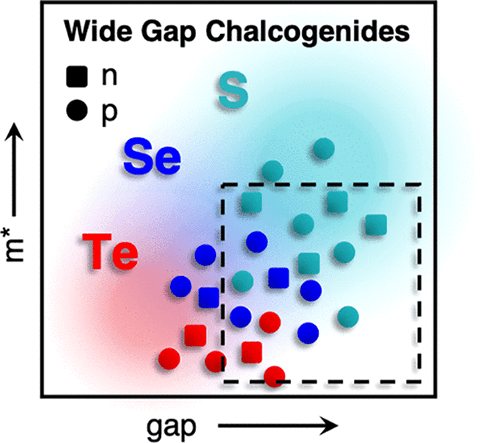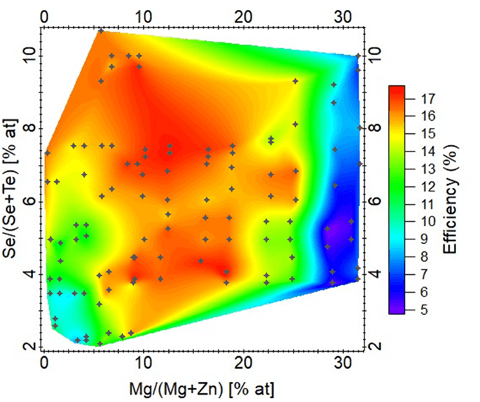Photovoltaic Materials Research
NREL's photovoltaic (PV) materials research focuses on light absorbers, transparent conductors, and PV devices.
Light Absorbers
This research focuses on synthesis of thin-film PV absorber materials (e.g., sulfides, oxides, and nitrides) and measurement of their properties (e.g., optical absorption, electrical conductivity, work function). Such research is the first step toward the material's practical use in devices, like PV solar cells.
For more information, see the following publications:
Zn2SbN3: Growth and Characterization of a Metastable Photoactive Semiconductor, Materials Horizons (2019)
A Review of Defects and Disorder in Multinary Tetrahedrally Bonded Semiconductors, Semiconductor Science and Technology (2016)
Combinatorial Insights into Doping Control and Transport Properties of Zinc Tin Nitride, Journal of Materials Chemistry C (2015).

Transparent Conductors
Wide-bandgap semiconductors are essential for today's electronic devices and energy applications because of their high optical transparency, controllable carrier concentration, and tunable electrical conductivity. For example, such transparent conductors, most commonly oxides, are used as contacts in thin-film solar cells.
For more information, see the following publications:
Wide Band Gap Chalcogenide Semiconductors, Chem Rev. (2020)
Non-Equilibrium Origin of High Electrical Conductivity in Gallium Zinc Oxide Thin Films, Applied Physics Letters (2013)
Optoelectronic Properties of Strontium and Barium Copper Sulfides Prepared by Combinatorial Sputtering, Chem. Mater. (2017).

Photovoltaic Devices
The ultimate goal of PV materials research is the practical application of new materials in useful devices such as solar cells. There is a myriad of interesting scientific challenges that arise from materials interactions, like those associated with integrating multiple materials with optimal properties into a single device. These include measurements of materials band offsets.
For more information, see the following publications:
Research Update: Emerging Chalcostibite Absorbers for Thin-Film Solar Cells, APL Materials (2018)
Trade-Offs in Thin Film Solar Cells with Layered Chalcostibite Photovoltaic Absorbers, Advanced Energy Materials (2017)
Sputtered P-type CuxZn1-xS Back Contact to CdTe Solar Cells, ACS Appl. Energy Mater. (2020).

Projects
The work on new PV materials for solar cells is funded by the U.S. Department of Energy through the Office of Energy Efficiency and Renewable Energy, Solar Energy Technology Program.
This project aimed to demonstrate potentially disruptive, novel PV absorbers by developing proof-of-concept PV device prototypes composed of defect-tolerant inorganic thin film oxide/nitride absorbers.
This project aimed to demonstrate the rapid development approach to thin-film solar cell development, on the example of devices made of abundant materials such as CuSbS2 and Cu2SnS3.
The primary objectives of this project were to identify earth-abundant, thermodynamically stable, and nonreactive Cu-M-N materials, determine their exact chemical stoichiometry and crystallographic structure, and study their physical properties related to photovoltaic applications.
The aim of this project was to develop a novel (Zn,Mg)Cu oxysulfide solar absorber material with the potential to reach and exceed 20% energy conversion efficiency, by substantially modifying the Cu2O base material by alloying with sulfur, zinc, and magnesium.
Contacts
Share
